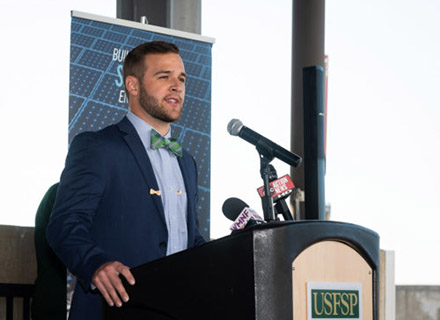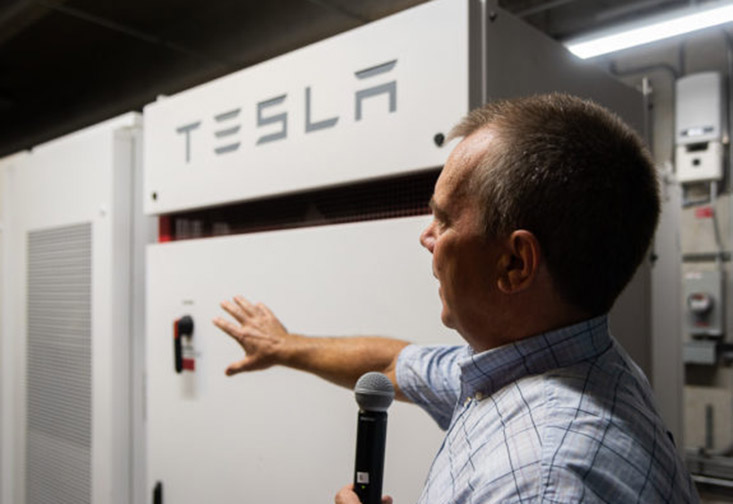Beneath a 100kW solar array and in front of dozens of community members and press, USF St. Petersburg and Duke Energy unveiled and demonstrated a Tesla battery solar storage system – the first of its kind in Florida.
This battery system manages the energy captured by the array, situated on top of the University’s parking garage. Measuring approximately 7,100 square feet and consisting of 318 individual panels on a freestanding canopy with space beneath for parking, the solar array was constructed three years ago through a $1 million grant from Duke Energy. Now the powerful battery system will ensure additional solar energy not used by the parking garage is stored or used for immediate use through the power grid.
“Taking steps to harness the power of the sun aligns perfectly with one of our core values as a university: sustainability,” said USFSP Regional Chancellor Martin Tadlock.
The parking garage’s elevator, lights and electric vehicle charging stations are powered by the energy collected by the solar array. Solar energy that is not used by the garage is stored in the 250-kilowatt Tesla battery system, to be used at night when the sun has set or during a power outage as a backup power source.
Duke Energy of Florida State President Catherine Stempien said battery costs have declined significantly over recent years, making such battery projects attainable and a reliable component for managing solar energy.
“They are a clean energy resource that will provide unique and flexible grid reliability that our customers want,” said Stempien.
The battery system will also provide benefits beyond the University. If more energy is produced than is being used by the garage and stored in the battery system, then it is fed back to the Duke Energy grid for immediate use by neighboring entities.
“We are able to monitor how much energy USF St. Petersburg is feeding back to the grid, and Duke Energy provides a credit back to the University,” said Stempien.
Monitoring is done through a new online dashboard and kiosk, which provides high-resolution data on the amount of solar energy being captured and how the storage system manages this energy. A kiosk located on the first floor of the parking garage will allow faculty and students to monitor the same data that Duke Energy does, providing greater insight into the system and educational opportunities.
“We can see currently that we’re making 33.1 kilowatts of power and that’s live, what’s happening right this second,” George Gurlaskie said, pointing to the online dashboard during a demonstration.

“We can also see historically, since 2016, we have made 383,191 kilowatts with this solar ray. That’s a good bit of power and energy” added Gurlaskie, a Technology Evaluation Manager at Duke Energy.
The solar battery storage system is just one of many sustainability initiatives taking place at the University. Over the past two years, the University signed onto a climate pact with the city of St. Petersburg to reduce its baseline greenhouse gas emissions by 50 percent by 2035 and to achieve carbon neutrality by 2050; erected a 40kW solar array that powers up to 15 percent of energy in new chemistry and biology labs; and the building that houses those labs earned LEED Platinum certification, becoming the first in the USF System to receive the highest sustainability distinction for buildings.
These accomplishments and more earned the University a spot in “Princeton Review’s Guide to 375 Green Colleges,” which highlights colleges with the most exceptional commitments to sustainability based on academic offerings and career preparation for students.
“As I have stressed to students and everyone on campus, it’s up to us to make a difference in our environment,” said Tadlock. “Every day, we need to make choices that will preserve and protect the natural world.”
